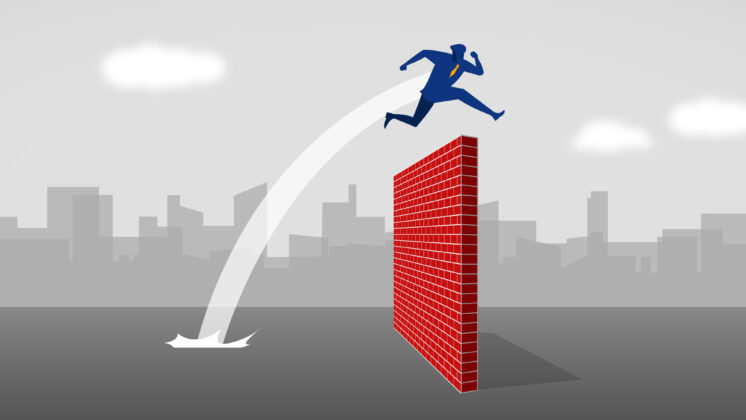Contrary to popular belief, being intelligent or logical does not automatically make you a critical thinker.
People with high IQs are still prone to biases, complacency, overconfidence, and stereotyping that affect the quality of their thoughts and performance at work. But people who scored high in critical thinking—a reflection of sound analytical, problem-solving, and decision-making abilities—report having fewer negative experiences in and out of the office.
Top 5 Barriers to Critical Thinking
To learn how to think critically, you’ll need to identify and understand what prevents people from doing so in the first place. Catching yourself (and others) engaging in these critical thinking no-no’s can help prevent costly mistakes and improve your quality of life.
Here are five of the most common barriers to critical thinking.
Egocentric Thinking
Egoism, or viewing everything in relation to yourself, is a natural human tendency and a common barrier to critical thinking. It often leads to an inability to question one’s own beliefs, sympathize with others, or consider different perspectives.
Egocentricity is an inherent character flaw. Understand that, and you’ll gain the open-minded point of view required to assess situations outside your own lens of understanding.
Groupthink and Social Conditioning
Everyone wants to feel like they belong. It’s a basic survival instinct and psychological mechanism that ensures the survival of our species. Historically, humans banded together to survive in the wild against predators and each other. That desire to “fit in” persists today as groupthink, or the tendency to agree with the majority and suppress independent thoughts and actions.
Groupthink is a serious threat to diversity in that it supports social conditioning, or the idea that we should all adhere to a particular society or culture’s most “acceptable” behavior.
Overcoming groupthink and cultural conditioning requires the courage to break free from the crowd. It’s the only way to question popular thought, culturally embedded values, and belief systems in a detached and objective manner.
Next Article
5 of the Best Books on Critical Thinking and Problem-Solving
Drone Mentality and Cognitive Fatigue
Turning on “autopilot” and going through the motions can lead to a lack of spatial awareness. This is known as drone mentality, and it’s not only detrimental to you, but those around you, as well.
Studies show that monotony and boredom are bad for mental health. Cognitive fatigue caused by long-term mental activity without appropriate stimulation, like an unchanging daily routine full of repetitive tasks, negatively impairs cognitive functioning and critical thinking.
Although you may be tempted to flip on autopilot when things get monotonous, as a critical thinker you need to challenge yourself to make new connections and find fresh ideas. Adopt different schools of thought. Keep both your learning and teaching methods exciting and innovative, and that will foster an environment of critical thinking.
Next Article
The Logic Tree: The Ultimate Critical Thinking Framework
Personal Biases and Preferences
Everyone internalizes certain beliefs, opinions, and attitudes that manifest as personal biases. You may feel that you’re open minded, but these subconscious judgements are more common than most people realize. They can distort your thinking patterns and sway your decision making in the following ways:
- Confirmation bias: favoring information that reinforces your existing viewpoints and beliefs
- Anchoring bias: being overly influenced by the first piece of information you come across
- False consensus effect: believing that most people share your perspective
- Normalcy bias: assuming that things will stay the same despite significant changes to the status quo
The critical thinking process requires being aware of personal biases that affect your ability to rationally analyze a situation and make sound decisions.
Allostatic Overload
Research shows that persistent stress causes a phenomenon known as allostatic overload. It’s serious business, affecting your attention span, memory, mood, and even physical health.
When under pressure, your brain is forced to channel energy into the section responsible for processing necessary information at the expense of taking a rest. That’s why people experience memory lapses in fight-or-flight situations. Prolonged stress also reduces activity in the prefrontal cortex, the part of the brain that handles executive tasks.
Avoiding cognitive impairments under pressure begins by remaining as calm and objective as possible. If you’re feeling overwhelmed, take a deep breath and slow your thoughts. Assume the role of a third-party observer. Analyze and evaluate what can be controlled instead of what can’t.
Train Your Mind Using the 9 Intellectual Standards
The bad news is that barriers to critical thinking can really sneak up on you and be difficult to overcome. But the good news is that anyone can learn to think critically with practice.
Unlike raw intelligence, which is largely determined by genetics, critical thinking can be mastered using nine teachable standards of thought:
- Clarity: Is the information or task at hand easy to understand and free from obscurities?
- Precision: Is it specific and detailed?
- Accuracy: Is it correct, free from errors and distortions?
- Relevance: Is it directly related to the matter at hand?
- Depth: Does it consider all other variables, contexts, and situations?
- Breadth: Is it comprehensive, and does it encompass other perspectives?
- Logical: Does it contradict itself?
- Significance: Is it important in the first place?
- Fairness: Is it free from bias, deception, and self-interest?
When evaluating any task, situation, or piece of information, consider these intellectual standards to hone your critical thinking skills in a structured, practiced way. Keep it up, and eventually critical thinking will become second nature.





